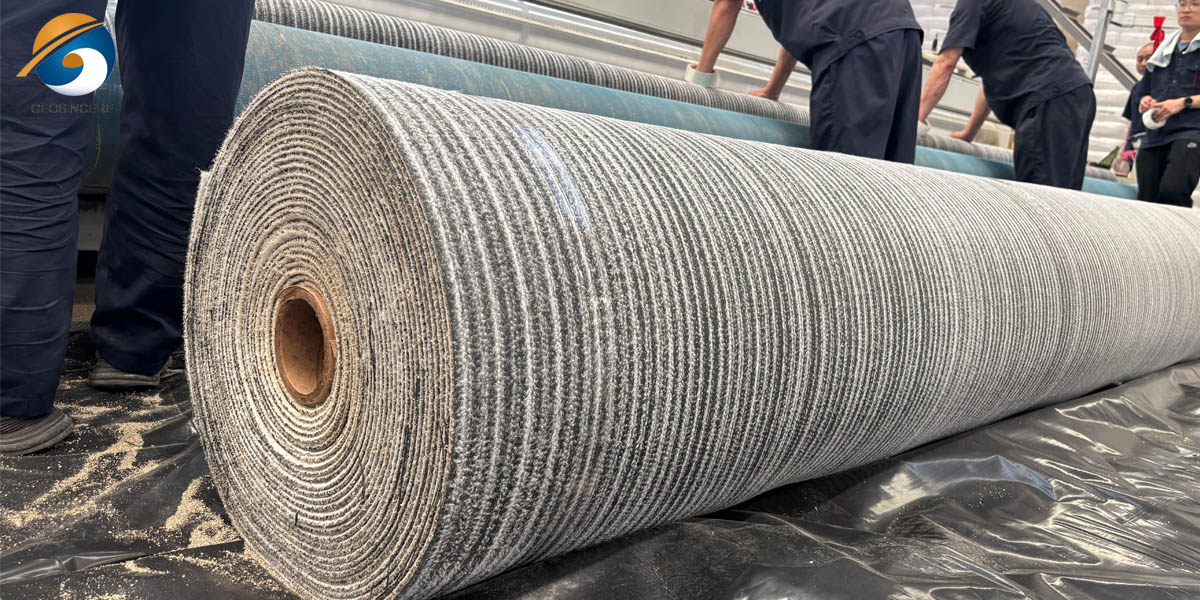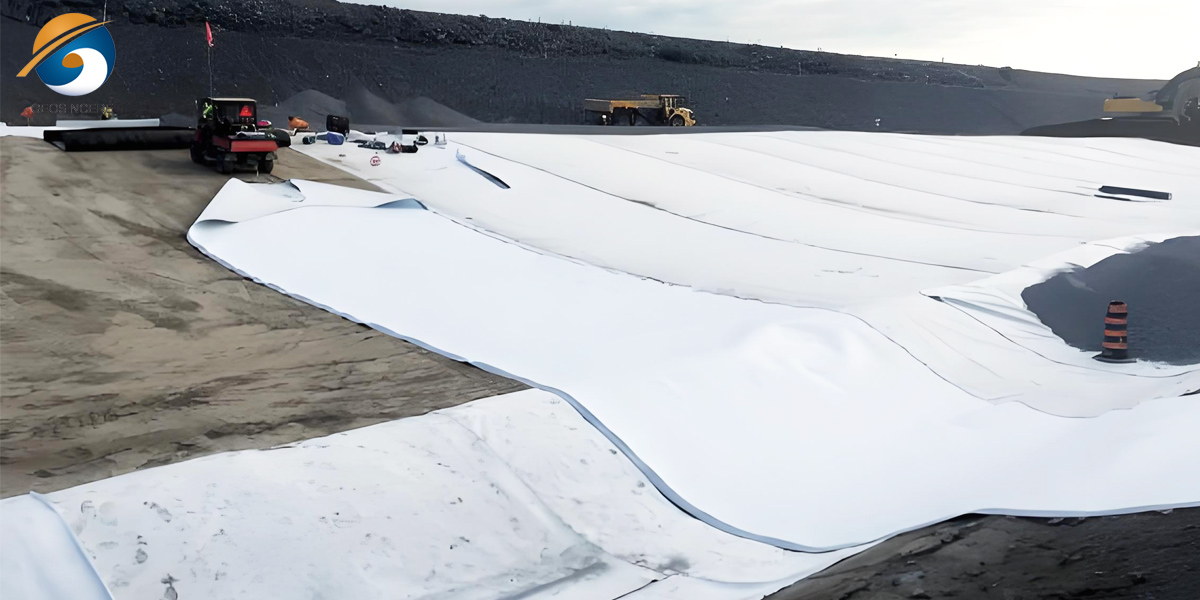Geosynthetic Clay Liner
Geosynthetic Clay Liner (GCL) is a high-performance geosynthetic barrier that combines a layer of herbal sodium bentonite clay between two geotextile or bonded to a geomembrane. The bentonite layer swells when hydrated, forming a low-permeability barrier that efficaciously prevents liquid migration. GCL liner is extensively used in environmental containment functions such as landfills, mining, wastewater therapy ponds, canals, and reservoir lining due to their most efficient sealing performance, ease of installation, and long-term durability.
- Excellent Sealing Performance – Bentonite clay expands upon hydration to create a self-sealing, extraordinarily impermeable barrier.
- Self-Healing Capability – Automatically seals small punctures or cracks triggered by way of agreement or set up damage.
- Geotextile Layers – Woven and/or nonwoven polypropylene geotextile
- Permeability – ≤ 5 × 10⁻¹¹ m/s after full hydration
Geosynthetic Clay Liner (GCL) is an superior geosynthetic barrier designed to furnish greatest impermeability in civil engineering and environmental containment projects. It consists of a layer of top rate sodium bentonite clay encapsulated between woven and/or nonwoven geotextiles, or bonded to a geomembrane for extra sealing. Upon hydration, the bentonite expands, forming a dense, low-permeability barrier that successfully blocks the passage of liquids, making GCL clay liner an best alternative or complement to regular compacted clay liner.
1. Geosynthetic Clay Liner Material Composition & Structure
1.1 Geosynthetic Clay Liner - Bentonite Core
The coronary heart of a geosynthetic liner is top rate herbal sodium bentonite, a clay mineral recognized for its super swelling potential and low hydraulic conductivity (≤ 5 × 10⁻¹¹ m/s after full hydration).
When uncovered to water, sodium bentonite can swell up to 15–18 instances its dry volume, filling voids and forming a dense, impermeable barrier.
This self-sealing property lets in the geo clay liner to keep integrity even if small punctures or cracks happen all through set up or carrier life.
1.2 Geosynthetic Clay Liner - Geotextile Cover Layers
Geo Synthetic Clay Liner is commonly sandwiched between two layers of geotextiles for mechanical safety and stability.
Nonwoven Geotextile Layer: Usually positioned on the facet dealing with the subgrade to enhance interface friction, decorate puncture resistance, and guard the bentonite from erosion.
Woven Geotextile Layer: Placed on the contrary aspect to supply excessive tensile strength, dimensional stability, and resistance to stretching at some stage in installation.
1.3 Geosynthetic Clay Liner - Bonding Methods
The bentonite layer is securely encapsulated the use of needle-punching, stitching, or adhesive bonding techniques.
Needle-punching robotically interlocks the fibers of the two geotextiles thru the bentonite layer, developing robust inner bonding that resists moving throughout transport and placement.
This bonding ensures even distribution of bentonite throughout the material and prevents clay migration for the duration of managing or hydraulic loading.
1.4 Geosynthetic Clay Liner - Optional Geomembrane Lamination
For initiatives that require more suitable chemical resistance or extraordinarily low permeability, a skinny HDPE or LLDPE geomembrane can be laminated to one aspect of the GCL.
This creates a dual-barrier system, combining the self-healing houses of bentonite with the impermeability of a artificial liner.
Geomembrane-laminated Bentonite Clay Liner is specifically superb in functions such as hazardous waste containment, industrial wastewater lagoons, and mining leach pads.
2. Geosynthetic Clay Liner Key Features & Benefits
2.1 Geosynthetic Clay Liner - Superior Sealing Performance
The sodium bentonite core in a clay liner can swell up to 15–18 instances its dry quantity when in contact with water.
This swelling motion fills voids, closes gaps, and varieties a continuous, low-permeability barrier that successfully stops water or leachate migration.
Unlike artificial membranes alone, bentonite’s self-sealing nature ensures sealing effectivity even underneath minor structural motion or soil settlement.
2.2 Geosynthetic Clay Liner - Self-Healing Properties
If the liner is punctured, torn, or develops small cracks in the course of set up or due to floor movement, the bentonite naturally expands into the broken area.
This self-repairing functionality substantially reduces the danger of leaks and extends the carrier lifestyles of the containment device except high priced repairs.
2.3 Geosynthetic Clay Liner - Chemical Resistance
GCL preserve sealing overall performance in contact with a range of harsh liquids, which includes acidic, alkaline, and saline solutions, as nicely as industrial effluents and landfill leachates.
When laminated with a geomembrane, the chemical resistance is in addition enhanced, making geo synthetic clay liner appropriate for hazardous waste and mining applications.
2.4 Geosynthetic Clay Liner - Durable & Long-Lasting
Manufactured with wonderful geotextiles and herbal bentonite, GCL are resistant to organic degradation, UV publicity (when covered), and freeze-thaw cycles.
Properly set up GCL can operate efficaciously for decades, presenting long-term containment security.
2.5 Geosynthetic Clay Liner - Quick & Cost-Effective Installation
Delivered in large, light-weight rolls, GCL is convenient to transport and installation except the want for heavy machinery.
Installation is quicker than regular compacted clay liners, decreasing labor necessities and undertaking prices whilst minimizing building timelines.
2.6 Geosynthetic Clay Liner - Eco-Friendly Solution
The use of herbal sodium bentonite gives a low-carbon, environmentally sustainable barrier material.
Unlike thick compacted clay liners, GCL require a long way much less excavation and transport of clay, decreasing environmental affect whilst keeping sealing effectiveness.
3. Geosynthetic Clay Liner Technical Specifications
Parameter | Typical Value / Range | Notes |
Core Material | Sodium Bentonite Clay | Swell index ≥ 24 mL/2g |
Clay Mass | 4–5 kg/m² | Customizable |
Thickness | 5–10 mm | Project-specific |
Width | 4–6 m | Custom widths available |
Roll Length | 20–50 m | Based on weight & handling |
Permeability | ≤ 5 × 10⁻¹¹ m/s | After full hydration |
Standards | ASTM D5887, GRI-GCL3, ISO | International compliance |
4. Geosynthetic Clay Liner Application Areas
4.1 Geosynthetic Clay Liner for Landfill Liners & Caps
Used as base liners to forestall leachate migration into surrounding soil and groundwater, and as capping structures to seal landfills after closure.
GCL grant a in your price range choice to thick compacted clay liners, presenting most useful sealing in a thinner profile.
- Example: In municipal stable waste landfills, geotextile clay liner is hooked up below HDPE geomembranes for a double-liner gadget that meets stringent environmental regulations.
4.2 Geosynthetic Clay Liner for Mining Operations
Essential in heap leach pads, tailings storage facilities, and waste rock containment areas to stop the break out of procedure options and contaminants.
GCL face up to chemical assault from cyanide, acids, and different mining system liquids.
- Example: In gold mining, GCL is positioned beneath heap leach pads to make certain that leaching options are contained and recovered efficaciously barring contaminating the environment.
4.3 Geosynthetic Clay Liner for Water Containment
Used in reservoirs, irrigation ponds, ornamental lakes, and aquaculture amenities to stop water seepage losses.
GCL can be hooked up over diverse subgrades and adapt to minor contract besides dropping impermeability.
- Example: In aquaculture shrimp farms, GCL serve as an underlayment under HDPE liners, offering more safety in opposition to punctures and seepage.
4.4 Geosynthetic Clay Liner for Wastewater Treatment
Installed in cure lagoons, sludge drying beds, and method water ponds to include beverages and guard underlying soil and groundwater.
GCL provide awesome resistance to natural count and therapy chemicals.
- Example: Municipal wastewater lagoons use GCL as a main liner to stop seepage of handled and untreated wastewater.
4.5 Geosynthetic Clay Liner for Environmental Remediation
Acts as a containment barrier for contaminated soil or groundwater at some point of remediation projects.
Prevents upward migration of pollution and downward infiltration of precipitation, helping in web page restoration.
- Example: In brownfield redevelopment projects, GCL is used as vertical and horizontal boundaries to isolate contaminated zones from smooth areas.
4.6 Geosynthetic Clay Liner for Tunnel & Underground Works
Applied as a waterproofing membrane for tunnels, subways, and underground buildings to stop water ingress.
Flexible adequate to conform to irregular surfaces and accommodate minor floor movement.
- Example: In metro tunnel projects, GCL is positioned between shotcrete layers to create a long-term waterproofing barrier.
5. Geosynthetic Clay Liner Installation Guidelines
5.1 Subgrade Preparation
Before putting in the GCL, put together the subgrade by means of making sure it is smooth, compacted, and free from debris, sharp stones, or vegetation that should puncture the liner.
Subgrade ought to be graded to the distinct slope for drainage, and any voids or depressions ought to be crammed to grant uniform guide for the GCL.
In rocky or uneven terrain, think about including a layer of first-class soil or sand for delivered protection.
5.2 Roll Placement
Position GCL rolls in accordance to the diagram plan, making sure that they are positioned in the right orientation (nonwoven or woven facet as specified).
When working on slopes, unroll the GCL downslope to minimize stress on seams and stop slippage for the duration of installation.
Handle rolls carefully to keep away from tearing or detrimental the geotextile surfaces.
5.3 Overlap & Seaming
Overlap adjoining GCL panels via a minimal of 300 mm (12 inches) to make certain non-stop coverage.
For more desirable sealing, sprinkle granular sodium bentonite powder or follow an permitted adhesive alongside the overlap quarter earlier than setting the subsequent panel.
Stagger overlaps in adjoining rows to keep away from growing non-stop joints that might also compromise barrier performance.
5.4 Anchor Trench
Secure GCL edges in anchor trenches positioned at the crest of slopes or perimeter boundaries to lock the liner in place.
Typical anchor trench dimensions are 300–500 mm deep and wide, backfilled with compacted soil after putting the GCL.
Anchoring prevents motion in the course of backfilling, covering, or beneath hydraulic pressure.
5.5 Hydration Control
Avoid exposing the GCL to moisture (rain or groundwater) earlier than it is included with defensive layers such as soil, sand, or geomembrane.
Premature hydration can motive the bentonite to swell too early, making coping with and placement difficult.
If sudden wetting occurs, set up must be paused, and any broken sections changed earlier than proceeding.
6. Geosynthetic Clay Liner Quality Assurance
GEOSINCERE Geosynthetic Clay Liners are manufactured in ISO-certified amenities and examined in accordance to ASTM, ISO, and GRI standards. Each batch undergoes:
- Swell index and fluid loss testing
- Bentonite mass per unit vicinity verification
- Tensile electricity and peel adhesion tests
- Permeability overall performance checks
- Visual inspection for defects and uniformity
These rigorous controls make sure steady product quality, dependable impermeability, and compliance with international engineering standards.
Conclusion
GEOSINCERE Geosynthetics Geosynthetic Clay Liner presents a reliable, high-performance answer for environmental containment and waterproofing applications. Combining top class sodium bentonite with long lasting geotextiles, it can provide extraordinary sealing, self-healing capability, and long-term durability. Manufactured to meet ASTM and ISO standards, GEOSINCERE GCL ensures regular best and demonstrated overall performance throughout landfill, mining, water containment, and civil engineering projects. For initiatives that demand greatest impermeability and low cost installation, GEOSINCERE is your depended on accomplice in geosynthetic solutions.















